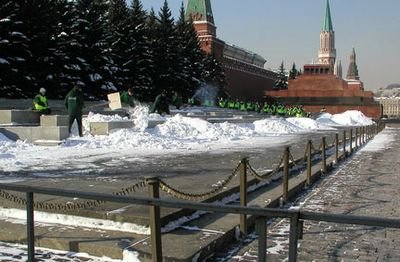On a bright morning in early March, I had 10 hours to fill in Moscow Red Square . St Basil’s Cathedral was exquisite in the early morning light and so, after photographing to my heart’s content and thawing my frozen fingers over a breakfast of tea and blini with a local friend at a quiet café, I headed toward Lenin’s Mausoleum, which overlooks the area.
Red Square is cordoned off in the mornings until the mausoleum closes at 1:00, we learned . That translates into walking about ten times farther than necessary to reach the entrance to the mausoleum. But that, dear comrades, is another story.
Lenin wanted to be buried next to his mother inSt Petersburg, they say
Lines are considerably shorter nowadays and on the day of my visit, only handful of us were there. I was totally fine with that. Once inside the mausoleum, it was quiet, dark and chilled. The narrow corridor was lined with black, granite-like stone leading to the steps down into the tomb. In the semi-darkness, only the face of a soldier was visible and he stood under a single light at the end of the corridor. His gloved hand was held chest-high and pointed to the right. So I went that-a-way. At the end of that corridor was the same sight, an expressionless face lit by an overhead light, a gloved hand pointing right. So I shuffled along in the dark, trying to anticipate the steps.
Lady, you must keep moving.
I was itching to jot down the details quick-like before I forgot. I stepped out into the sunlight, reached for my notebook and started scribbling notes. I needed a place to sit and write. What better place than those stone benches that flank the mausoleum. Before brushing off the snow to sit down, I walked over to the guard for permission.
Nyet, you’ve got to keep moving.
Red Square and his full attention was on me.
Russia Russia
How about you, dear Blog Reader, have you visited Lenin's Mausoleum? Please do share. . .
Lenin wanted to be buried next to his mother in
Lines are considerably shorter nowadays and on the day of my visit, only handful of us were there. I was totally fine with that. Once inside the mausoleum, it was quiet, dark and chilled. The narrow corridor was lined with black, granite-like stone leading to the steps down into the tomb. In the semi-darkness, only the face of a soldier was visible and he stood under a single light at the end of the corridor. His gloved hand was held chest-high and pointed to the right. So I went that-a-way. At the end of that corridor was the same sight, an expressionless face lit by an overhead light, a gloved hand pointing right. So I shuffled along in the dark, trying to anticipate the steps.
Lady, you must keep moving.
Well, okay, I thought. But I’m the only one in here at the moment, save for those ever-so-watchful guards. I’ll keep moving but it will be slow enough that I can soak in details. See, a person can walk around that coffin in a heartbeat and that’s the end of it. From there, another dark corridor leads outside. There are no displays and no memorabilia. No photographs and no plaques. All is very solemn, quiet and dignified. And very black.
I was itching to jot down the details quick-like before I forgot. I stepped out into the sunlight, reached for my notebook and started scribbling notes. I needed a place to sit and write. What better place than those stone benches that flank the mausoleum. Before brushing off the snow to sit down, I walked over to the guard for permission.
So, how about if I just stand here and write, I bartered?
* * * * *
How about you, dear Blog Reader, have you visited Lenin's Mausoleum? Please do share. . .





No comments:
Post a Comment